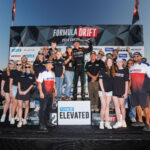Formula Drift introduces new regulations for the 2023 season — a new scoring system for competition, qualification scoring and judging. Drift.news reviews vital changes below.

New stuff for 2023
Competition points: 1st – 100, 2nd – 88 (was 90), 3rd – 76 (was 80), 4th – 64 (was 80), 5th-8th – 48 (was 67), 9th-16th – 32 (was 52), 17th-32nd – 16 (was 35).
The rotational panel of judges. The driver’s steward position is fixed.
Drivers will complete up to two non-consecutive runs in order of the current Championship standing (the last ranked driver goes first) in the Knockout Qualifying Format.
Qualifying criteria and scoring: line – 40%, angle – 30%, style – 20%, X-Factor – 10%. Every judge can award run with maximum of 100 points and average will be calculated.
X-Factors are points of a difference a driver can make, creating a clear and notable difference in performance and execution relative to other drivers. These are the “Wow” factors. Some descriptors are:
• Heavy, controlled throttle usage
• Driving with a big angle but maintaining a consistent pace
• Showing vehicle stability and balance while performing at a very high level of driving

More criteria were added to incomplete qualifying runs. F.e., hood, hatch, roof, trunk and/or doors opening during a run, a mix of multiple mistakes that could be classified as an Unchaseable Lead, not maintaining control across the finish line.
INCOMPLETE, in tandem, is an inactive chase and unchaseable lead, not maintaining control across the finish line.

When rainy conditions happen, the Competition Director and Race Control will evaluate the situation and determine the best possible options for continuing. In most cases, whether in Qualifying or Tandem, the drivers can do “sight” laps to physically evaluate the track conditions at least once before their battle.
In the event of Run 1 contact without an incomplete, defined as when a vehicle touches another vehicle and/or part of the course and generally stays uninterrupted in line and angle, judges will no longer determine fault for the incident. Both drivers may request up to 5 minutes to repair their vehicle without using their designated Competition Timeout. Abuse of this can lead to penalties.

If contact with an incomplete occurs, the Judges will ascertain fault using all resources (replays, track staff, memory, etc.).
In the event of Run 2 contact without an incomplete, defined as when a vehicle touches another vehicle and/or part of the course and generally stays uninterrupted in line and angle, judges will no longer determine fault for the incident. In this case, no additional repair time will be allocated as the battle has been completed.
The Decel light is a tool used to help judges make more accurate decisions on whether or not a driver is decelerating in an area he/she should not and then what the consequence of that decel is. The Decel Light, like every other tool (cameras, replays, drones, etc.), is subject to each judge’s interpretation and should not be considered a black-and-white issue. Blue = Neutral, Green = Acceleration, Yellow = Deceleration not meeting the “Decel” threshold, and Red = Deceleration that meets the “Decel” threshold.
A protest against an entry, the validity of an entrant or driver, or a vehicle’s eligibility may be made at any time. All vehicle eligibility protests will be reviewed and arbitrated by the Competition Director. Protests will be allowed in all rounds of tandem competition except the Finals.




